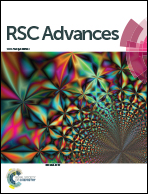Photochemically assisted one-pot synthesis of PMMA embedded silver nanoparticles: antibacterial efficacy and water treatment†
Abstract
One-pot synthesis of polymer embedded silver nanoparticles (AgNPs) by the UV irradiation method was performed and thoroughly characterized. Electron microscopy analysis revealed that AgNPs (17.30 nm) were embedded into the PMMA matrix. High-resolution transmission electron microscopy (HRTEM) study indicates that the silver–poly(methyl methacrylate) (Ag–PMMA) nanocomposite exhibited internal highly ordered lattice fringes of the Ag (111) lattice plane. The Ag–PMMA nanocomposite had a lower tendency to agglomerate than borohydride reduced AgNPs as evaluated by stability experiments. The nanocomposite shows a zeta potential of −63.9 mV confirming the high stability of the nanocomposite. Organic reagent tests reveal that the synthesized nanocomposite contains a greater amount of Ag0-state particles and a lesser amount of Ag+ ions. Fourier transform infrared spectroscopy (FTIR) studies evidenced that the carbonyl group of PMMA binds to AgNPs. The nanocomposite exhibited excellent antibacterial performance against Gram negative Escherichia coli, Pseudomonas aeruginosa and Gram positive, Staphylococcus aureus. Moreover, the possible mechanism for the antibacterial activity of the Ag–PMMA nanocomposite with E. coli bacteria was discussed. In addition, the Ag–PMMA nanocomposite solution was loaded onto a membrane (the ‘treated membrane’) for water treatment applications and characterized by spectroscopy techniques. Sludge water was passed through the treated membrane and the effluent water was analyzed for viable bacteria. Deactivation of bacteria by percolation through the treated membrane occurred. Consequently, the filter effluent contains dead bacteria, which indicates that the treated membrane exhibits antibacterial properties. Interestingly, microwave plasma-atomic emission spectrometry (MP-AES) analysis estimated that silver loss in the treated membrane was less than 0.1 ppm.


 Please wait while we load your content...
Please wait while we load your content...